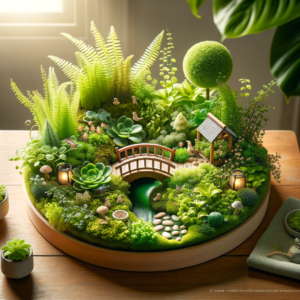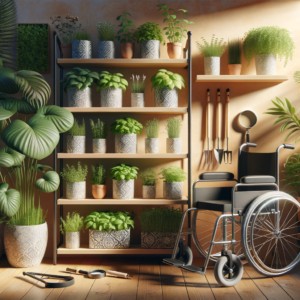In the realm of indoor adaptive gardening, air-purifying plants offer a dual benefit: they beautify your space while actively improving air quality. This comprehensive guide explores the best air-purifying plants for indoor environments, their care, and how to incorporate them into adaptive gardens for improved health and well-being.
Understanding Air Pollution in Indoor Spaces
- Common Indoor Pollutants:
- Volatile Organic Compounds (VOCs)
- Dust and particulate matter
- Mold spores
- Carbon dioxide
- Sources of Indoor Air Pollution:
- Furniture and carpets
- Cleaning products
- Electronic devices
- Poor ventilation
- Health Impacts of Poor Indoor Air Quality:
- Respiratory issues
- Headaches and fatigue
- Allergic reactions
- Long-term health risks
Benefits of Air-Purifying Plants in Adaptive Gardens
- Natural Air Filtration: Remove toxins and pollutants from the air
- Increased Oxygen Levels: Improve overall air quality
- Humidity Regulation: Help maintain optimal indoor humidity
- Stress Reduction: Presence of plants can lower stress and anxiety
- Aesthetic Appeal: Enhance the visual appeal of indoor spaces
- Low Maintenance: Many air-purifying plants are easy to care for
- Therapeutic Benefits: Gardening activities provide physical and mental stimulation
Top Air-Purifying Plants for Indoor Environments
- Spider Plant (Chlorophytum comosum):
- Removes formaldehyde and xylene
- Easy to grow and propagate
- Snake Plant (Sansevieria trifasciata):
- Filters benzene, formaldehyde, trichloroethylene, xylene, and toluene
- Tolerates low light and infrequent watering
- Peace Lily (Spathiphyllum):
- Removes ammonia, benzene, formaldehyde, and trichloroethylene
- Thrives in low light conditions
- Boston Fern (Nephrolepis exaltata):
- Removes formaldehyde and xylene
- Acts as a natural humidifier
- Bamboo Palm (Chamaedorea seifrizii):
- Filters benzene, formaldehyde, and trichloroethylene
- Adds a tropical touch to indoor spaces
- Aloe Vera:
- Removes formaldehyde and benzene
- Has additional medicinal properties
- Rubber Plant (Ficus elastica):
- Eliminates formaldehyde
- Tolerates low light conditions
- Dracaena Species:
- Various types remove different pollutants
- Come in multiple sizes and varieties
Care Tips for Air-Purifying Plants
- Watering:
- Allow soil to dry between waterings for most species
- Use well-draining potting mix
- Light Requirements:
- Most air purifiers tolerate low to medium light
- Rotate plants periodically for even growth
- Humidity:
- Many air-purifying plants prefer higher humidity
- Use pebble trays or room humidifiers if needed
- Fertilizing:
- Feed monthly during growing season with balanced fertilizer
- Reduce or stop fertilizing in winter
- Cleaning:
- Dust leaves regularly to maintain air-purifying efficiency
- Wipe with a damp cloth or give plants a gentle shower
Placement Strategies for Maximum Air Purification
- High Traffic Areas: Place plants in frequently used rooms
- Near Potential Pollution Sources: Position near electronics or new furniture
- Bedroom Placement: Improve air quality for better sleep
- Grouping Plants: Create plant clusters for increased humidity and purification
- Vertical Gardening: Utilize wall space for additional plants
- Bathroom Benefits: Many air purifiers thrive in humid bathroom environments
Combining Air-Purifying Plants with Adaptive Gardening Techniques
- Raised Planters: Elevate plants for easy access
- Self-Watering Systems: Reduce maintenance for those with limited mobility
- Lightweight Containers: Use plastic or fiber clay pots for easier handling
- Vertical Gardens: Wall-mounted options for space-saving and accessibility
- Rolling Plant Stands: Allow for easy relocation of larger plants
- Adaptive Tools: Long-handled tools and ergonomic watering cans for easier care
Maintaining Indoor Air Quality Beyond Plants
- Regular Ventilation: Open windows when possible
- Air Purifiers: Complement plants with electronic air purifiers
- Vacuum Regularly: Reduce dust and particulate matter
- Natural Cleaning Products: Minimize chemical pollutants
- Control Humidity: Use dehumidifiers in damp areas
- Avoid Smoking Indoors: Eliminate a major source of indoor pollution
Seasonal Considerations for Indoor Air-Purifying Gardens
- Winter Care:
- Reduce watering frequency
- Provide supplemental humidity if using heating systems
- Consider grow lights for shorter days
- Summer Adjustments:
- Increase watering as needed
- Protect plants from direct air conditioning drafts
- Monitor for pest issues more frequently
- Spring Revitalization:
- Repot or refresh soil as needed
- Increase fertilization as growth resumes
- Prune and shape for healthy new growth
- Fall Preparation:
- Gradually reduce watering and fertilizing
- Clean leaves thoroughly before reduced winter light
- Check for pests before bringing outdoor plants inside
Air-Purifying Plants Safe for Pets and Children
- Spider Plant: Non-toxic and safe for pets and children
- Boston Fern: Pet-friendly and effective air purifier
- Bamboo Palm: Safe for pets and kids
- Areca Palm: Non-toxic and excellent air purifier
- Money Plant: Safe and effective at removing formaldehyde
- Lemon Button Fern: Pet-friendly and adds delicate texture
Propagation Methods for Air-Purifying Plants
- Stem Cuttings:
- Effective for pothos, philodendron, and dracaena
- Root in water or moist soil
- Division:
- Suitable for spider plants and peace lilies
- Separate during repotting
- Leaf Cuttings:
- Works well for snake plants
- Plant leaf sections directly in soil
- Offshoots:
- Spider plants produce easy-to-root “babies”
- Aloe vera produces pups for propagation
Troubleshooting Common Issues with Indoor Air Purifiers
- Yellowing Leaves: Often indicates overwatering or nutrient deficiency
- Brown Leaf Tips: Can be caused by low humidity or fluoride in water
- Pest Infestations: Inspect regularly and treat promptly with natural methods
- Slow Growth: May indicate insufficient light or nutrients
- Leaf Drop: Often due to sudden changes in environment or overwatering
Enhancing Air Purification with Technology
- Smart Plant Sensors: Monitor soil moisture, light, and temperature
- Automated Watering Systems: Ensure consistent care for optimal health
- Air Quality Monitors: Track improvements in air quality
- Grow Lights: Provide supplemental light for optimal growth
- Smart Humidifiers: Maintain ideal humidity levels for plants and air quality
Conclusion
Incorporating air-purifying plants into indoor adaptive gardens offers a natural, effective way to improve air quality while enjoying the many benefits of gardening. These plants not only filter harmful pollutants from the air but also add beauty and life to indoor spaces, making them perfect for individuals with limited mobility or those seeking low-maintenance gardening options.
By choosing the right plants, understanding their care needs, and combining them with adaptive gardening techniques, anyone can create a thriving indoor garden that contributes to a healthier living environment. Remember, the key to success with air-purifying plants is to select species that match your care abilities and environmental conditions.
Whether you’re looking to improve your home’s air quality, add some greenery to your space, or explore the therapeutic benefits of gardening, air-purifying plants offer an accessible and rewarding way to bring nature indoors.
FAQ
- Q: How many plants do I need to improve air quality in a room? A: A general rule is to have at least one medium to large plant per 100 square feet of space for noticeable air quality improvement.
- Q: Do air-purifying plants remove odors as well? A: While plants primarily remove chemical pollutants, some, like peace lilies, can help reduce certain odors in the home.
- Q: How often should I replace the soil in my air-purifying plants? A: It’s generally recommended to refresh or replace the soil every 12-18 months to ensure optimal nutrient levels and air-purifying efficiency.
- Q: Can air-purifying plants grow in offices with fluorescent lighting? A: Many air-purifying plants, such as snake plants and pothos, can tolerate and even thrive under fluorescent lights.
- Q: Are there any air-purifying plants that are safe for people with pollen allergies? A: Yes, plants like snake plants, spider plants, and peace lilies are generally considered good choices for allergy sufferers as they don’t produce much pollen.



